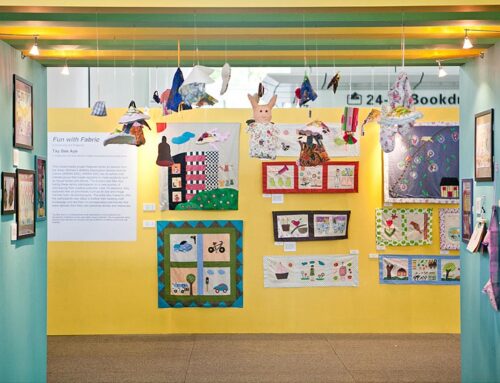Library / Field Studies
The Value of Co-Creation in Arts-Based Community Development
Library / Field Studies
The Value of Co-Creation in Arts-Based Community Development
Lessons from The Greenhouse Lab
What does co-creation mean to you? Perhaps you have heard this word often lately, owing to its rising influence in various fields. This could point to a paradigm shift towards shared decision-making and participation. Or maybe it signifies the underlying universal human desire to connect, learn from one another and grow together.
Co-creation does not just mean working together, but stands for many valuable practices in collective efforts. At ArtsWok Collaborative, we see co-creation as a methodology guiding each of our programmes. It is a foundational process of participation that enables people of different backgrounds (knowledge, skills, perspectives) to build something together using arts-based processes. Key to this process is the intentionality of the relationships involved, in which power is shared and communication is open.
In our programme The Greenhouse Lab1, which wrapped its second edition in Yuhua during May 2022, co-creation was an important guiding principle. Comprising our eight Labbers were: art educators, an art therapist, arts managers, an architect, a facilitator and a community worker. The result of their co-creation through the Lab was a successful pilot programme, Thrive-Thru, centred on mental well-being for youths. It was designed, implemented, monitored and evaluated by the Labbers under our DIME model.
Recently, we interviewed five of the Labbers, Stacy Huang, Nah Yong En, Karen Koh, Jezamine Chua and Sarah Tang. This resulting article serves as a receptacle for their insights on co-creation, and how engaging in co-creation has brought value to them. To do so, we explore the different ‘co’-s that surfaced as a result of co-creation during the Lab: such as cooperation between individuals, combining strengths across disciplines, a sense of collectiveness through shared decision-making, among others.
Co-creation may seem intimidating, especially to someone new to it, and who may see it as a field-specific jargon. However, it is a mindset, process, approach, and methodology that anyone can adopt when working with others. We hope this reflection of co-creation during The Greenhouse Lab could serve as food for thought for you to think about how you may co-create with others around you, too.
Co-Creation Through the Eyes of the Labbers
Before embarking on their Greenhouse Lab journey, some of the Labbers had already undergone co-creation in their fields of work, to various degrees.
Stacy, an art educator for young children, co-creates art projects daily with her students. During such experiences, she plays a more principal role as the instructor, providing guidance. Karen, an art therapist, had opportunities to work with other arts practitioners to create meaningful art programmes engaging the community in senior-centric settings. Architect Jezamine experienced co-creating during her undergraduate days, through a participatory action research project with Vietnamese students in a suburban district at the fringe of Ho Chi Minh City.
Yong En—an arts management lecturer, and Sarah—an independent arts producer who also manages partnerships and communications part-time at a Family Service Centre, both profess to not have had much exposure to co-creation prior to the Lab.
All these varying backgrounds and perspectives on past experiences of co-creation have given rise to different ideas on what co-creation may entail. Here is a constellation of our Labbers’ different views on co-creation:
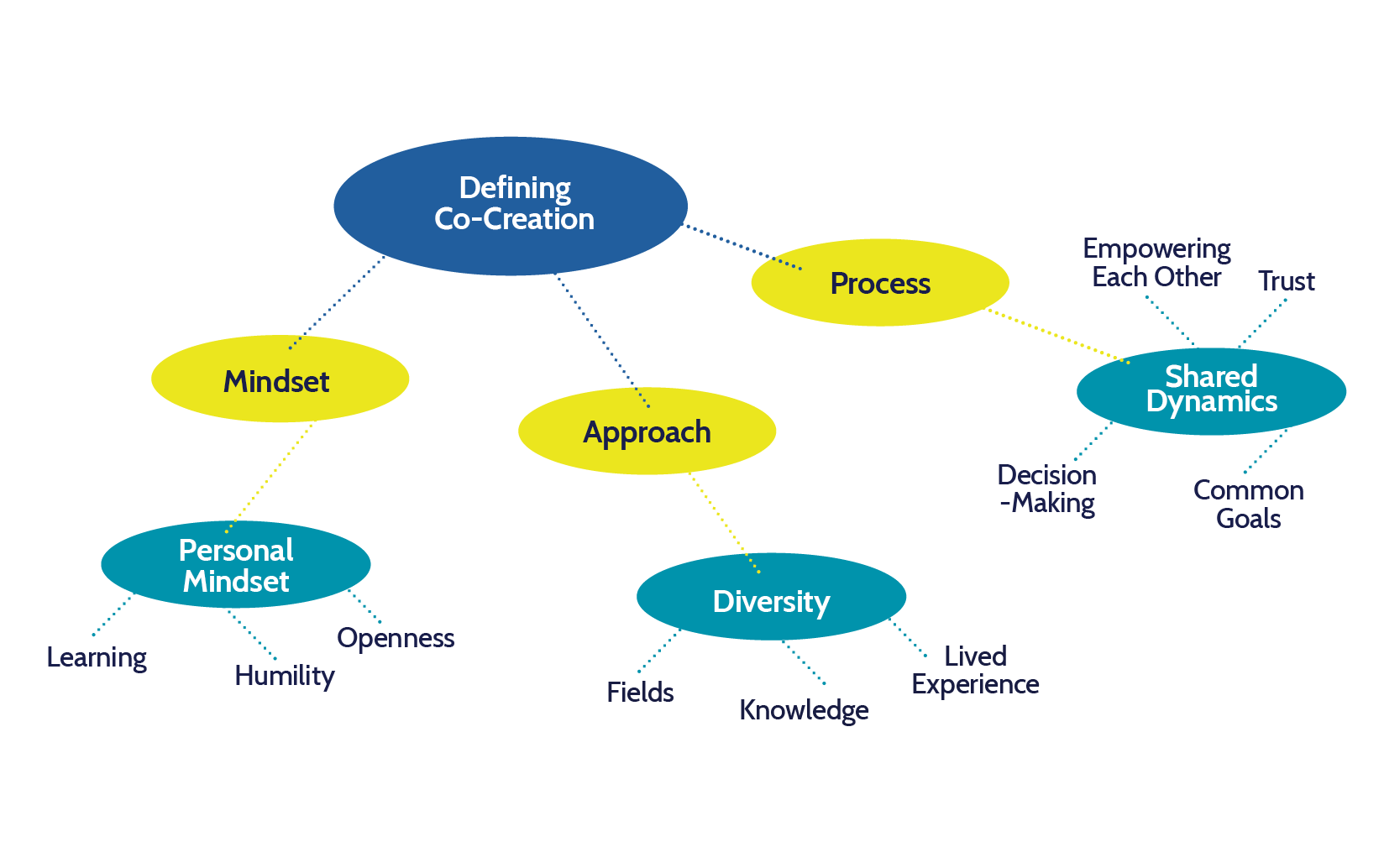
Constellation design by Joe Chan.
This suggests that there are multiple facets to co-creation, and perhaps no one set way of defining it. Rather, there are certain fundamental factors to co-creation which vary to certain extents based on the situation and relationships involved.
For instance, whether the structure of such working relationships is pre-determined or decided by the co-creators together. Some Labbers did not consider their participatory experiences prior to the Lab as co-creation, because they were coming into a programme only after its design to provide inputs to it.
For others, the dynamics between co-creators are more important, such that they embrace co-creation as more of a mindset than methodology. This is encapsulated in Jezamine’s reflection that co-creation is a “mindset which stems from a genuine love for one’s fellow living beings… a deep desire to understand and enable one another.”
Common to each of their understandings of co-creation is the need for a shared goal. Yet such a goal need not be rigid: it may evolve along the way, and be transformed through processes of negotiation. Stacy reflects that for such negotiations to be smooth, “bonding to develop trust is essential before and during the process.”
An interesting take emerged from Karen, who sees the process of conducting therapy as a form of co-creation: in deciding together the outcomes of sessions with clients, and in co-creating therapist-client relationships through art-making. This suggests a fluidity of what the outcome of co-creation may be, that it need not be a tangible end-goal.
The need for humility is important and noted by each of them. The Labbers’ shared willingness to learn from one another led to a group dynamic of openness and mutual respect. Hence, the attitude you bring to a relationship of co-creation is key. How do you define co-creation for yourself? And how might this impact the way you approach co-creation when working with others?
We have so far explored the Labbers’ individual perceptions and experiences of co-creation. In the next few sections, we will discover how the Labbers co-create, and the different ‘co-‘s that arose as a result, providing them with invigorating opportunities to learn.
Connecting with One Another – the Foundations for Cooperation to Flourish
A prerequisite for co-creation is a group of people who are able to cooperate with one another. While co-creators need not know one another prior to working together, the process of becoming familiar with each other and connecting on a deeper level—beyond the level of mere acquaintance—is crucial to forming group dynamics.
During The Greenhouse Lab’s first phase, comprising Community Cultural Mapping, the eight Labbers worked together under the guidance of Janet Pillai—veteran cultural researcher and practitioner—to understand the needs of the youths of Yuhua.
This entailed using various data collection methods, such as participatory activities, compiling and conducting surveys or learning the stories of the community through conversations. Such a range of activities encouraged the Labbers to learn what one another’s strengths and relevant lived experiences were.
Over time, a sense of camaraderie was established amongst the Labbers. A strong understanding of others’ circumstances helped to foster mutual trust, and a sense of empathy and compassion for one another. While these are traits of a cooperative relationship of co-creation, they also aided their making of Thrive-Thru. As Jezamine reflects, these values are essential for making a programme about mental wellness, to understand the mental struggles youths may face.
In fact, the Labbers had co-created a safe relational space by connecting with one another, wherein they could begin developing Thrive-Thru together. The next time you set out to co-create with others, perhaps you can start by setting the intention to connect with your fellow co-creators, and think of what values you would like this relational space to be shaped by.
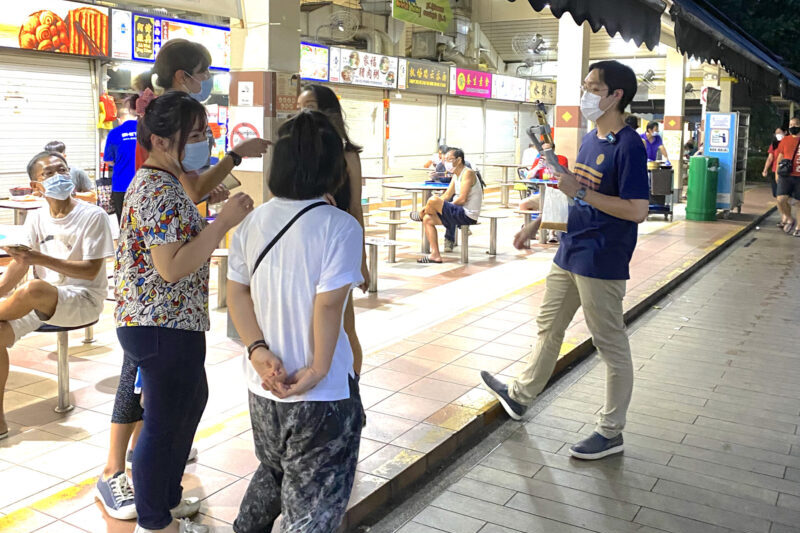
The Labbers exploring the neighbourhood of Yuhua during the Community Cultural Mapping phase of the Lab.
Combining Diverse Strengths and Learning from One Another
At ArtsWok, co-creation is a methodology that encourages strength from diversity. Thus, we brought together a group of Labbers from different fields, with different expertise. Having such diversity come into play encourages creative approaches to emerge. On an individual level, each co-creator stands to benefit from such diversity, as it creates opportunities for them to learn from their peers.
During the phases of planning and designing Thrive-Thru, the different backgrounds of the Labbers allowed each of them to put their skills to good use, and cover one another’s blind spots. For instance, Yong En, as a teacher of art programme design, could provide feedback on what ideas might or might not work in practice. Sarah, with her experience in producing and working with youths in a university-setting, could advise on how youths might be better engaged. Jezamine, as an architect, could apply design-thinking tools to help synthesise ideas.
When the strengths of a Labber came into play, the others would make it a practice to step back, letting them take the lead. Underlying this ability to hold space for one another’s strengths to shine through was the cooperative dynamic they had built together. They understood that they are peers to one another and worked in a non-hierarchical manner together. Through this, the Labbers learnt how to empower one another when co-creating; as phrased by Karen, to “support whoever [is] on the ball”.
Working with people from different fields or backgrounds from yourself can be daunting. Yet, co-creation can help you embrace such differences. It provides opportunities to uplift one another’s strengths, and through this, innovate novel solutions together.

Stacy Huang explaining one of the activities to the youths during Thrive-Thru.
Communicating with Openness
When groups of people with different backgrounds and training come together on an equal playing field, it is natural for differences in personality and opinion to arise. In co-creation, where the diversity of ideas is encouraged, disagreement is a welcomed development.
During The Greenhouse Lab, the facilitators of ArtsWok avoided stepping in as much as possible during discussions, to allow the Labbers autonomy over decision-making processes. From within the group of the eight Labbers, there organically emerged facilitators who stepped up occasionally to encourage those who were less vocal to share their ideas. Others learnt to step back when they realised another’s expertise was more beneficial to the project.
From a personal point of view, Yong En shares that to iron out differences, one must have the patience to sort out the knitty-gritty through detailed discussions. The Labbers’ commitment to such an openness helped to maintain this cooperative dynamic during the Lab; this entailed a constant process of recalibrating oneself with respect to others, prioritising the need to understand other points of view before making group decisions. Jezamine further noted on this point: “In such a [co-creative] space, it is more important that empathy and compassion prevails in our interactions among the Labbers, and we stay coherent to the same values that drive us in our mission for the youths.”
A journey of co-creation may therefore enable someone to become a better communicator and competent team member; not only in bringing across one’s ideas but also being receptive to those of others.
Forming Collectiveness Across Boundaries
A group of seven youths joined as the participants of Thrive-Thru. The Labbers’ goal was to use Thrive-Thru as a platform to develop youth mental wellness resources, together with these youths who were “equal stakeholders” of this project. It would be the youths’ ideas and interventions going into the making of these resources. However, to encourage youths to contribute as their equals comfortably, the Labbers were well aware they would have to bridge the generational gap and the facilitator/participant divide.
To break these barriers, the Labbers participated alongside the youths in activities conducted by community partners or themselves in turns; subsequently, they developed mental wellness resources together. These shared processes all helped the youths see the Labbers as peers. Through this, an open space within Thrive-Thru was created: the Labbers noted the youths’ openness, “wisdom and courage”, to share in “unbridled” ways their personal encounters with mental health and their experiences of supporting others grappling with such issues. This was perhaps in reciprocation to the Labber’s own candour with the youths from the outset by being clear with their objectives for the programme. At times, the Labbers would step back and allow the youths to take charge, thus giving them a further sense of agency and ownership over the project.
The processes of co-creation not only enable co-creators to connect across differences but also power differentials. With Thrive-Thru, the Labbers and youths overcame the generational gap by co-creating together, forming a collective dynamic and operating as equals. While power dynamics of the world external to the scenario of co-creation are not erased, co-creators may cooperate with one another on an equal footing, fostering the growth of mutual understanding.
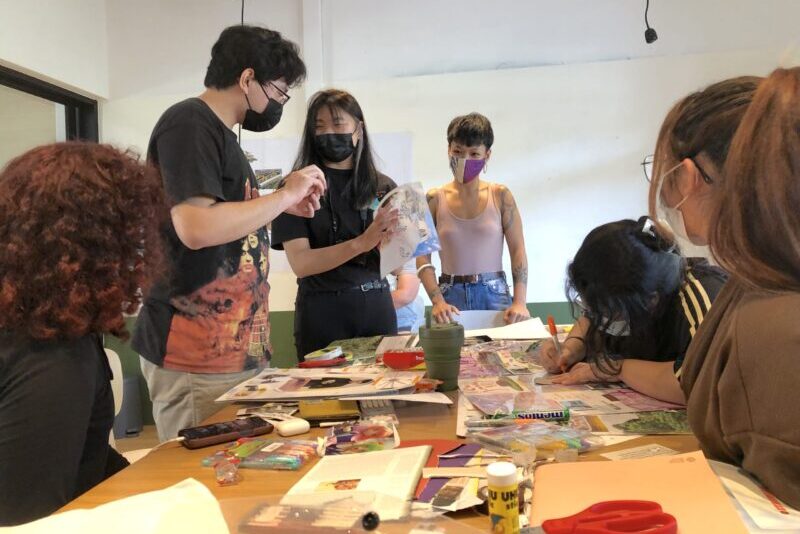
The Labbers, Thrive-Thru participants and ArtsWok staff working together.
Co-Creating Through Arts-Based Processes
Two partners, Izzaty Ishak and Khoo Yi Feng, joined during the early stages of Thrive-Thru, to aid the Labbers in their understanding of youth mental wellness. Izzaty—then the artist-facilitator of The Community Theatre (Beyond Social Services)—worked closely with Karen to develop a session using applied theatre activities. Yi Feng, of Limitless—a non-profit which provides support to youths—worked closely with Yong En to develop life-visualising activities such as the Tree of Life and River of Life.
Such activities, and their careful planning and facilitation, were crucial ingredients to emerging a co-creative space of not only openness but also “braveness” (as said by Izzaty). The process of sharing was grounded and nurtured through these activities, which Yong En emphasised, gave the youths more holistic ways to look at their lives, and to extrapolate insights on mental wellness.
On this, Jezamine shares: “Having witnessed how arts-based and hands-on activities allow participants to express themselves freely and create their own experiences, this experience of co-creation has renewed my belief in the arts as a valuable platform and safe space for informal dialogue and introspection.”
Co-creation is often referenced in the context of a professional field, and the tools to co-create together may differ from field to field. In our field of arts-based community development, art processes are often used as the medium for co-creation to occur, given their potential as powerful tools to immerse people in the process and connect them. Through their participation in the Lab, the Labbers shared that their arsenal of co-creative tools has grown, giving them food for thought on how to shape their future endeavours in co-creation.
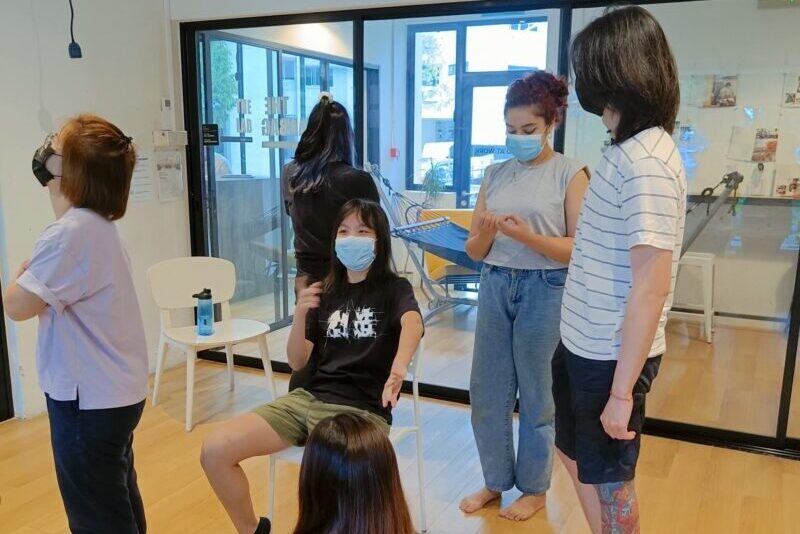
The Labbers and the youths participating together in theatre-based activities during Thrive-Thru.
Continuing to Co-Create After the Lab
The Labbers have learnt in different ways from this experience of co-creating together, and we have likewise learnt much from them. At the conclusion of each of our interviews with them, we asked them what their personal takeaways are from this process.
Some of the Labbers have set goals to co-create with communities in the future. This experience of working with youths through Thrive-Thru has cemented Karen’s belief that a community should be able to take ownership of work that concerns them. Jezamine and Sarah both stress the importance of listening when co-creating, so that a programme would be shaped according to a community’s needs. Sarah sees this as a conscious cycle of recalibration throughout a programme’s run: “I have learnt that it is equally important to give space for the participants to tweak and materialise their own experiences in their own ways, in order to co-create meaningfully.”
Others who do not directly work with communities have decided to imbue co-creation into selected steps of their work. For instance, Yong En sees co-creation as a valuable method of collecting data when preparing to develop a programme, as cooperative activities encourage participants to share their stories. Others have resolved to use co-creation as a mindset to approach work, whether it be in partnerships with others during projects, negotiations during group discussions, or encouraging colleagues to utilise it for administrative processes. Jezamine stresses on the value of co-creation within the field of architecture, as “the creation of generative and collaborative tools allows non-designers to influence the design and decision-making processes of architects”. Accordingly, she wishes to advocate it as a mindset amongst her fellow architects.
Embarking on Your Own Journey of Co-Creating with Others
We hope that having read this piece, you too have begun considering how co-creation may help you work with others, especially with people different from you. For this, we have compiled a list of recommendations from our Labbers that might help you on this journey:
- As an individual: Bear in mind that attitude is important. Always carry with you the intent to listen and learn from others. Set aside your ego. Along the way, keep an open mind and be adaptable to the ideas of others.
- Create a safe space: The foundation to any dynamic of co-creation is trust. Strive to create a safe relationship with each of your co-creators, free of preconceived notions.
- Have a shared common purpose: This need not be set in stone, and may be negotiated along the way.
- Power dynamics: During the process, co-creators should operate as equals, sharing decision-making power; although they may take turns to step up and take the lead. If disagreements arise, bringing in an external mediator when tensions run high might be useful to maintain a cooperative relationship. This person should not be part of the decision-making processes.
- Communication is essential: To facilitate this process, brainstorming tools enable co-creators to invite and visualise ideas, and assess them more fairly together. Creative approaches and artistic methods are good avenues for introspection, dialogue and exchange.
[1] The Greenhouse Lab is an action-learning programme organised and presented by ArtsWok Collaborative since 2014. With our latest two iterations, the Lab has equipped arts and other practitioners with the skills and knowledge to design (D), implement (I), monitor (M) and evaluate (E) arts-based community development projects (the DIME model). This edition in Yuhua was presented with Bold At Work, and supported by Our Singapore Fund.
Cover Image: The Labbers with the youth participants during Thrive-Thru. ‘Let’s Go Mama Shop’ is an intervention designed to share community mental wellness resources they developed together for youths.
About Kirin Heng

Kirin was Communication Manager at ArtsWok Collaborative. She is a writer on social issues and art researcher who believes in the power of the arts to transform society. Aside from editing and writing for ArtsWok, she has written articles published by The HEAD Foundation (Disability-Centred Arts), Unseen Art Initiatives with National Gallery Singapore (Unseen Inside Out), and Brack. She holds a Master of Arts (Research) and Liberal Arts and Sciences BA (Hons) Degree, both from Utrecht University (The Netherlands), and speaks English, Dutch and Chinese. Her educational background and training encompass anthropology, media, literature, film, and performance studies alongside critical theory.





